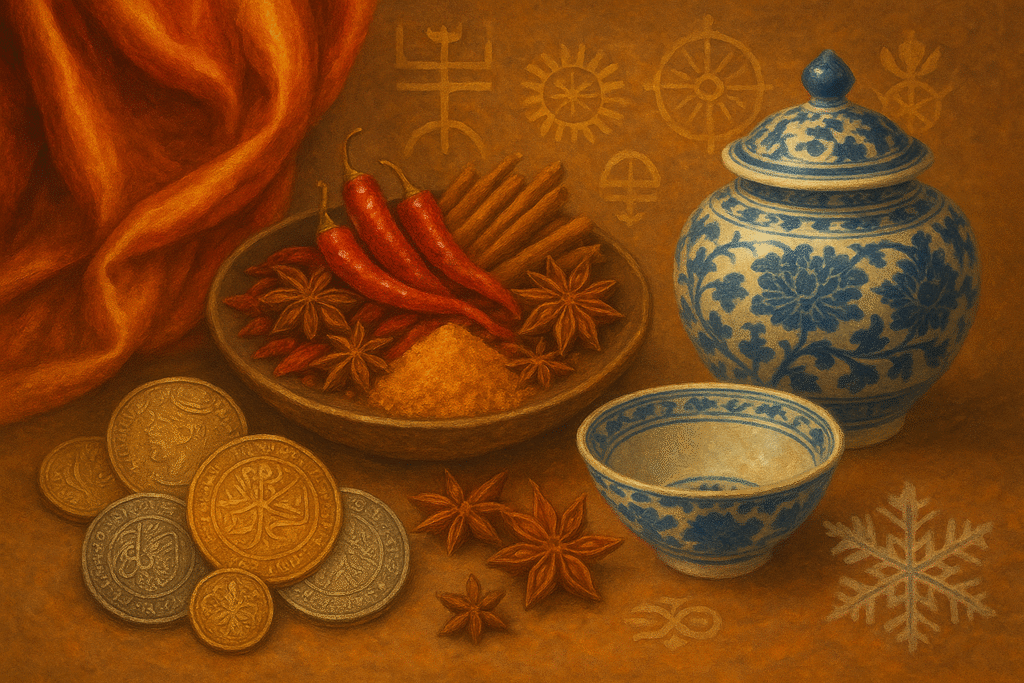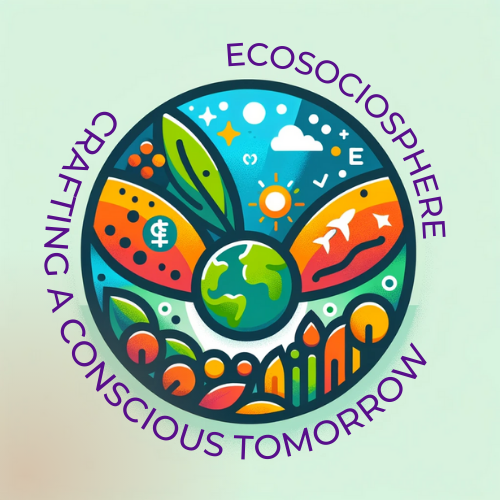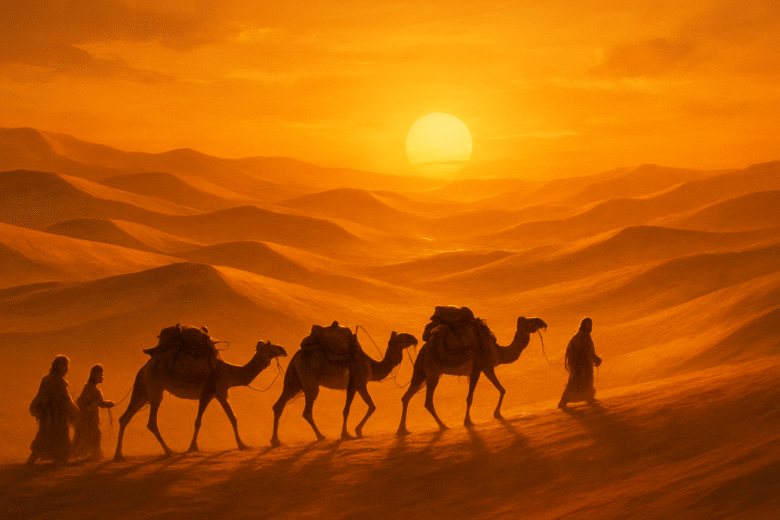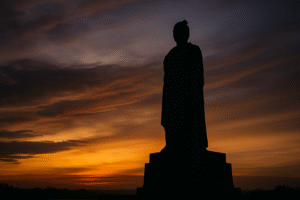Fun Fact: The first “global” pandemic—the Plague of Justinian—may have hitchhiked its way to Europe through the Silk Road, hidden in the fur of rats aboard caravans.
When we think of ancient trade routes, we often imagine camels trudging through deserts loaded with silk, gold, and spices. But trade routes like the Silk Road or the Maritime Spice Route weren’t just delivery networks for merchandise—they were highways for ideas, beliefs, languages, diseases, fashion, art, and even recipes. In fact, these ancient trails did more to shape the modern world than most history textbooks let on.
This is a story about the invisible cargo—the cultures, customs, and consequences—that flowed alongside the silk and saffron.
The Silk Road: Not Just Silk
The Silk Road wasn’t one road, and silk wasn’t its only offering.
Stretching over 6,000 kilometres across Asia, the Silk Road connected China to the Mediterranean and passed through bustling hubs like Samarkand (in modern-day Uzbekistan), Persepolis (Iran), and Constantinople (now Istanbul). While Chinese silk was the showstopper, the road also carried paper, porcelain, jade, horses, carpets, and—perhaps most powerfully—religions and ideologies.
Buddhism, for instance, spread from India to China and then to Korea and Japan through these routes. Buddhist monks didn’t just travel with scrolls—they built monasteries along the way, some of which still stand today in places like Dunhuang (China), where intricate cave art tells stories of both trade and transcendence.
And then there’s Islam, Christianity, and Zoroastrianism—all of which found new believers thanks to traders who brought more than goods in their saddlebags.
More Than Merchants: Cultural Diplomats on the Move
Every merchant was a little bit of a diplomat, translator, and traveller of the human spirit.
Consider the Sogdians—an Iranian-speaking community—who played a key role as cultural intermediaries across the Silk Road. They translated texts, married across cultures, and introduced Chinese porcelain to Persia and Persian music to China. They were the Wi-Fi of the ancient world—connecting ideas and identities wherever they stopped.
Similarly, Indian traders introduced not just spices, but numerical systems, textiles, and even vegetarian cuisine to the Southeast Asian world. In return, Indian temples adopted architectural styles from Khmer (Cambodian) and Javanese influences. Your dosa may be local, but some of the techniques that made it crispy came from far away.

Illness, Inheritance, and Catastrophe: The Hidden Costs of Global Linkages
Not all exchanges were golden. The same routes that ferried civilization also transmitted pandemics.
The Black Death, which killed up to 60% of Europe’s population in the 14th century, likely travelled via trade routes from Central Asia. Fleas infected with Yersinia pestis (the bacterium causing plague) found passage through trading caravans and ships.
But it wasn’t just disease that travelled—it was people. With every migration wave, ancient trade routes became highways for intermarriage, genetic mixing, and even slavery. Roman coins found in Indian ports tell us that Roman traders (and sometimes slaves) ended up in Tamil Nadu, just as Indian elephants were once gifted to Roman emperors.
Trade blurred boundaries. You couldn’t neatly label a civilization “pure” after centuries of mutual influence.
Ports, Recipes, and Rhythms: Everyday Globalization
Visit a coastal town in Kerala and you’ll hear stories of Arab traders who arrived not with armies but with dates and poems. You’ll taste a biryani that carries Persian influences. You might even see ancient churches built by Syrian Christians—descendants of traders and missionaries who came two millennia ago.
In Southeast Asia, the Javanese gamelan music carries echoes of Indian ragas. African kora rhythms found their way into the Iberian Peninsula through Moorish traders, indirectly influencing Flamenco.
Even something as simple as tea has a trade story. China may have discovered it, but it was through the Silk Road that tea reached Central Asia, became chai in India, and eventually turned into the British “afternoon tea”—a colonial echo of an ancient sip.
The Maritime Routes: Oceans as Highways
We can’t forget the Maritime Silk Route, often overshadowed by its land-based cousin. Long before Vasco da Gama found his way to India, Arab, Chinese, and Malay ships were trading goods and stories across the Indian Ocean.
Ports like Calicut (Kozhikode), Malacca, and Zanzibar weren’t just marketplaces—they were melting pots. Here, languages like Swahili (a blend of Arabic, Bantu, Persian, and Hindi) were born. Coastal architecture in these cities tells a story of Islamic domes meeting Chinese tiled roofs.
And let’s not forget the spices: cloves from the Moluccas, cinnamon from Sri Lanka, nutmeg from Banda—flavors that shaped European colonial ambitions and reshaped entire economies.

Currency, Calendars, and Clocks: A Shared Time
Trade also standardized time.
The need to coordinate trade encouraged the development of common currencies, weights, and measures. The Indian concept of zero (a game-changer in mathematics) reached the Arab world through trade and eventually transformed global science.
Calendars, too, were shared across cultures. India’s lunisolar calendar shared striking similarities with the timekeeping systems of ancient China, the Hebrew tradition, and Islamic cultures. As merchants travelled, so did their understanding of time, seasons, and celestial navigation. Trade didn’t just move goods—it moved entire worldviews.
Conclusion: The Threads We Still Carry
When we scroll through Amazon (owned by Amazon.com, Inc., a U.S.-based e-commerce and tech company) or pay using Unified Payments Interface (UPI), we’re engaging in a new kind of trade route—one that moves bytes instead of camels. But the idea is old.
Trade routes—ancient or modern—have always been about more than the movement of material things. They’re about what happens when people meet, when tongues mix, when food is shared, and when worldviews collide and combine.
So, the next time you sip your coffee (originally from Ethiopia), wear cotton (domesticated in India), or listen to jazz (with roots in African rhythms), remember: you’re living the legacy of ancient trade. Goods are temporary. But ideas? They travel forever.
Author’s Note
History often highlights battles and borders, but it’s trade—the quiet, constant pulse of human exchange—that has shaped us more deeply. In tracing the old routes, we’re really tracing who we are. And who we’ve become.
G.C., Ecosociosphere contributor.
References and Further Reading
- Silk Road – UNESCO World Heritage Centre
- How the Silk Road Made the World Smaller
- https://www.voanews.com/a/black-death-likely-originated-in-central-asia-researchers-say/6628848.html




